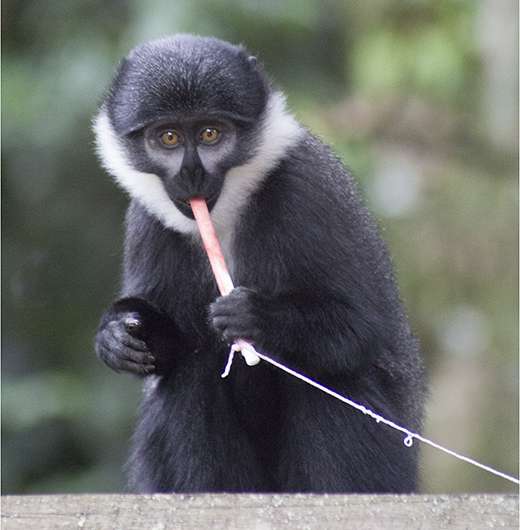Rope-chewing technique an easy way to screen monkeys for disease

A noninvasive technique involving strawberry jam and a piece of rope is helping surveillance for diseases that might jump from monkeys to humans according to a study from the University of California, Davis.
The UC Davis One Health Institute's PREDICT Project has been performing global disease surveillance for more than five years, but the logistics of screening primates for zoonotic pathogens—diseases that can be passed from animals to humans—have often presented a challenge. That is because invasive sampling techniques, such as collecting blood or using oral swabs, require anesthesia in the field.
UC Davis graduate student researcher Tierra Smiley Evans and the PREDICT team have now developed a noninvasive method to simplify the sampling of primates in challenging, remote locations. The method is described in a study published in June in the journal PLOS Neglected Tropical Diseases.
Simple and affordable
"It's important that we're able to sample wildlife in communities where zoonotic diseases are likely to emerge," said Smiley Evans. "This technique is aimed at helping to make that possible."
Simple and affordable, the method opens new doors for the study of primates as sources of diseases that could affect humans in remote tropical settings.
"This method is already being deployed in multiple countries throughout the world as part of the PREDICT project and is expanding our ability to investigate primate populations that we were previously unable to sample," said UC Davis professor Christine Kreuder Johnson, surveillance lead for the PREDICT project and senior author on the study.
How it works
A six-inch piece of weaved rope made from nylon or cotton is dipped into an attractant such as strawberry jam. The ropes are tossed near the animals being targeted for sampling, which pick up the ropes, chew on them and drop them.
Researchers can then collect saliva from the discarded ropes.
"It's important to try and throw the rope without the primate seeing where it came from," said Smiley Evans. "We have to be sneaky. Some species, like macaques, are very bold in urban settings and it's easy to get mobbed by monkeys."
The sample is taken to a lab, where teams test it for viral diseases that may pose a direct threat to humans.
In this study, oral samples were collected from multiple species, including rhesus macaques in Nepal and olive baboons, red-tailed guenons and L'hoest's monkeys in Uganda. A variety of viruses, including herpesviruses and simian foamy viruses, were detected in those samples.
Going viral
Wild primates are prime candidates for passing diseases to humans because they are closely related to us genetically and, in many parts of the world, regularly come into contact with people.
For example, at sacred temples in Kathmandu, Nepal, rhesus macaques roam the temple grounds and exist among the tourists and locals who pass through the temple. Food and other items can often exchange hands. And in the remote town of Buhoma in Uganda, red-tailed guenons come down from the trees to investigate people and look for food.
These kinds of human-animal interfaces need monitoring most, the researchers said, because they lend themselves to the spillover of pathogens that can cause a pandemic.
Viruses that originate in wild animals account for more than 70 percent of emerging zoonotic diseases in humans, including viruses that have caused pandemics such as HIV/AIDS, epidemics such as Ebola and smaller outbreaks like Marburg hemorrhagic fever.
More information: Smiley Evans T, Barry PA, Gilardi KV, Goldstein T, Deere JD, Fike J, et al. (2015) Optimization of a Novel Non-invasive Oral Sampling Technique for Zoonotic Pathogen Surveillance in Nonhuman Primates. PLoS Negl Trop Dis 9(6): e0003813. DOI: 10.1371/journal.pntd.0003813
Journal information: PLoS Neglected Tropical Diseases
Provided by UC Davis















